Peanut Butter is a staple food on the trail here in the US. It is inexpensive and is available in the most remote corner stores. The creamy consistency makes it easy to smear on crackers and bagels for a quick calorie boost. Peanut butter also lends substance and rich flavor to oatmeal, rice, and noodles.
Nutritionally, peanuts are also a win. They’re loaded with healthy monounsaturated fat and protein, making them especially great for vegetarians. And peanuts, like all plant foods, contain no cholesterol.
Here we’ll explore the different types of peanut butter and which ones are best suited for backpacking.
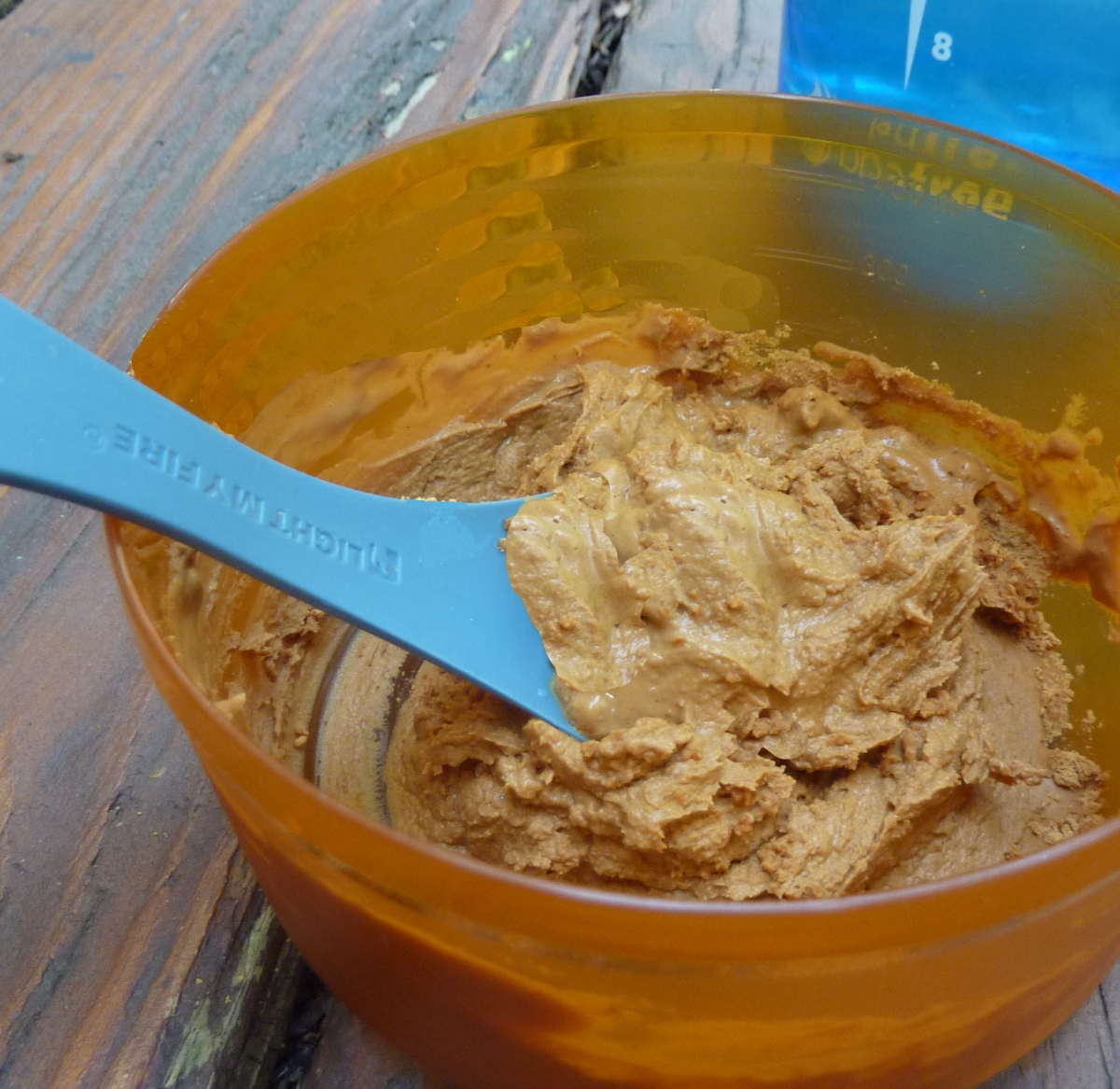
Peanut History
First, a quick history of peanuts.
Unlike most crops, peanuts have remained unmodified. All peanuts originate from the same plant, Arachis hypogaea, and today’s peanut is nearly identical to its original ancestor dating back 10,000 years ago. You won’t have to worry about GMOs when it comes to peanuts—at least when it comes to the seed. That said, growing and processing peanuts may convince you to consider only organic. Most peanuts grown in the US South are rotated in fields that contain genetically engineered cotton, a crop used in our food supply that is treated with a controversial pesticide and weed killer.
Peanuts are technically not a nut but part of the legume family related to green peas. The peanut is the seed of a small leguminous bush called a geocarpic plant because it pushes its fruit underneath the ground. Once you dig it out from the soil, you’ll find that the peanuts don’t have a hard shell that protects them like a true nut (i.e., walnut, almond). Instead, peanuts are covered in a thin, wrinkly, woody shell (pod), often containing two kernels covered by a brown seed coat. The soft pod is very porous and is prone to pests eating the kernel and developing fungal growth. Thus, conventional peanuts are heavily sprayed with pesticides and fungicides. We recommend purchasing Valencia peanuts grown in drier climates like New Mexico or organic peanuts to reduce exposure. Outdoor Herbivore only uses organic peanuts.


Peanuts are a common staple food in the USA, thanks to George Washington Carver’s encouragement in the 20th century. Carver suggested Southern farmers replace their weevil-ravaged cotton with peanut food crop instead. He also suggested it be marketed as human food. During that time, peanuts were only used as animal feed. His suggestion worked. Today, nearly all US-grown peanuts come from the southeast states, primarily Georgia and the Carolinas. Peanuts are a staple in many dishes, from peanut butter to soups to candies.
Peanut Nutrition
Peanuts are an excellent source of nutrition. Peanuts contain monounsaturated fat, protein, carbohydrates, antioxidants, manganese, niacin, folate, and copper. Peanuts also contain beneficial phytochemicals such as beta-sitosterol, and the skin contains resveratrol, the same antioxidant found in red wine, both of which are good for the heart.
As a legume with high protein content, the peanut is one of the world’s most important staple foods.
Peanut Butter, 2 TB (32g)
- 13% Carbs
- 72% Fat
- 15% Protein
One serving, or two tablespoons of peanut butter, typically contains 190 calories, 7 grams of protein, and 16 grams of fat, with about one-half as monounsaturated and one-third polyunsaturated, with the remaining 15 percent saturated.
Calorie Breakdown of Peanut Butter, 2 TB (32g) = 190 Calories
- Carbs 7g
- Fat 16 g
- Protein 7g
Carrying out peanut butter for the trail
When backpacking, you may not want to carry an entire jar with you. Plastic jars are heavy and can crack and make a mess. Fortunately, packaging comes in different formats. These are the best packaging options for foot travel –
Squeeze Packs
Single-use foil packets are convenient if you desire a small dose of peanut butter. The small amount is fine for day or weekend hikers, who often don’t need the extra food calories from a larger serving. The single-serve packets must be massaged a few times before opening to soften and release the butter.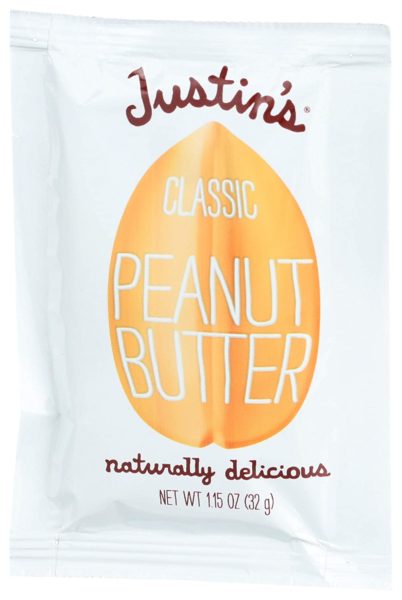
Peanut Powder
Rather than carrying around individual squeeze packets, a less wasteful and lighter option is a peanut powder. Outdoor Herbivore offers a dry peanut powder created for backpackers. Unlike the popular peanut powders marketed for dieters, our peanut butter powder contains fat from U.S. grown organic high-oleic peanuts, providing high calories and a long shelf life.
The advantage of peanut powder is that you make as much as you need by adding water directly to the mix or a dish. Powder eliminates the mess of squeeze tubes and the waste of single-serve packets. Hi-oleic peanuts are unique in that they have an oleic acid ratio more closely resembling olive oil rather than standard peanuts.
- 1 ounce of Outdoor Herbivore’s roasted organic peanut butter powder contains 150 calories, 8 grams of fat, 12 grams of protein, 8 grams of carbs, and 0 mg of sodium.
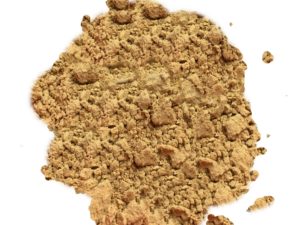
Squeeze tubes are not recommended.
Loading the peanut butter will not be easy, and it won’t work for natural peanut butter because it is not pliable enough to squeeze out. Squeeze containers also don’t work well when the weather turns cold because the peanut butter hardens and becomes difficult to release. If you have a non-portable container of peanut butter that you want to use up, you’re better off just taking it with you or repacking it in a smaller plastic container with a locking lid.
Types of Peanut Butter
Packaging is one of many things to consider when traveling with peanut butter. There’s also several different varieties.
Low Fat Peanut Butter
Reduced-fat peanut butter (i.e., PB2) is typically made by replacing a portion of the peanut fat with soy protein and sugar. Peanuts may also be defatted and replaced with nothing at all. Unless you are trying to restrict calories and lose weight while backpacking, you should skip low-fat and no-fat peanut butter.
Conventional Peanut Butter
Standard (shelf-stable) peanut butter is the most common peanut butter you’ll find in stores. It contains about 90% peanuts, up to 6% sugar, 2% salt, and additives to improve shelf life and stirring—often hydrogenated oil, such as soybean oil or palm oil.
Hydrogenated oil prevents the peanut oil and peanut solids from separating and improves shelf life. It also acts as a preservative to prevent rancidity by slowing the rate of oxidation. Unfortunately, this hydrogenated oil often means it contains a small amount of nasty trans fat. Note: If you are trying to avoid trans fats (and you should), here is something you should know. 0% trans fats do not mean zero trans fats. 0% can be claimed if it contains less than .49 g per serving (where serving size can be shrunken as needed to meet that claim). You can determine if PB contains trans fat if you see the addition of Monoglycerides and Diglycerides on the ingredient label. Adding mono/diglycerides is a tactic used by food manufacturers to chemically lower the trans fat content to make the “no trans fat” claim. A typical serving for most adults will be around 2 TB (1 oz. or 28g).
- The advantage of “regular” PB is that it requires no refrigeration because it contains added preservatives to keep the oils from turning rancid when exposed to oxygen. The disadvantage is that the hydrogenated oil contains a small amount of trans fat, and the oil is often GMO (soy or cottonseed). It is also higher in sugar and sodium.
- Conventional peanut butter does not contain organically grown peanuts. Although peanuts are non-GMO, growing conventional peanuts requires a high concentration of pesticides. Pesticide intake from residues on foods may adversely affect human health[2]
Natural Peanut Butter
Natural peanut butter contains 100% peanuts. It may also contain a small amount of salt or natural sweeteners, such as maple or honey. It does not have hydrogenated oil or trans fats. The lack of hydrogenation means the natural peanut oil will separate and rise to the top of the jar. It must be stirred to make it uniform. Also, natural peanut butter has no preservatives and can spoil at a faster rate. It should be stored cold if not consumed within 4-6 weeks of opening. Conversely, storing the PB in a warm location (like your pack) will make the oil separate faster and eventually turn rancid. Despite common belief, storing natural peanut butter in a refrigerator is unnecessary. The rancidity rate depends on several factors, such as temperature, moisture in the air/peanut butter, how often the container is opened, cross-contamination from dirty fingers/saliva, cleanliness of the container, etc. You can expect Natural PB to last at least 1 month without refrigeration under most conditions. Just taste it to test if it is still good. It will smell musty and tastes stale as it starts to spoil (still OK to consume) and then taste sour or bitter once rancid.
- Refrigeration helps slow the oxygenation rate (spoilage) and minimize oil and solid separation, but keeping natural PB cold is unnecessary. How to tell when PB has gone bad: if it tastes or smells bad, it is bad.
- Natural PB is healthier. The downside is that it may harden and be difficult to spread without stirring it.
- When purchasing peanut butter, we recommend one made with roasted peanuts instead of raw. Aflatoxin (produced from a carcinogenic fungus) and Salmonella is a common problem of improper storage & handling of raw nuts.[1]The roasting process destroys aflatoxin and is believed to improve digestibility.
- We recommend using organic peanuts since peanuts are considered a “dirty” crop due to their extensive use of pesticides, namely herbicides (to kill weeds) and fungicides (to kill fungal disease).[2]
- Chunky versus Creamy is a matter of preference. Creamy PB is most certainly better suited for the trail since it readily squeezes out and spreads without utensils. Calorie-wise, chunky and creamy are the same.
Ways to Incorporate Peanut Butter on the Trail for Added Calories
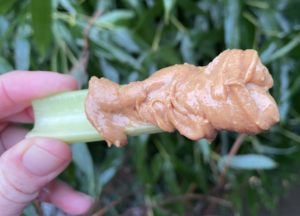
- Roll up in a tortilla with dried fruit, or make a plain peanut butter flatbread sandwich.
- Scoop it up with celery sticks, which will stay firm in your pack for several days.
- Eat with a spoon on its own for added protein and fat.
- Add to oatmeal, noodles, or rice for a creamy texture.
- Toast bread over a campfire and then smear the PB. The PB will turn warm and gooey when spread on warmed bread. Try it on toast, pita, bagels, or tortilla wraps (rolled and warmed up with raisins or other dried fruits), crumpets/English muffins (it oozes into all the little crevices).
- Share it with your trail dog, who also needs the added fat. Smear over an aspirin tablet if your dog needs one while on the trail.
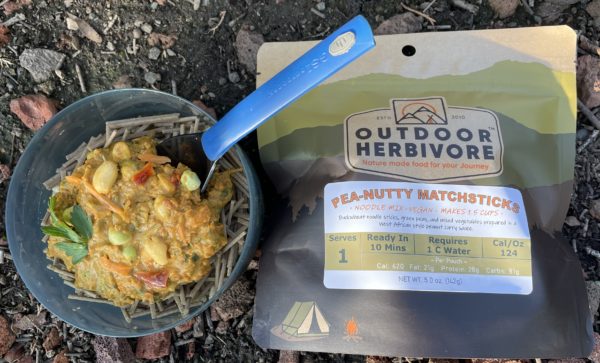
What is your favorite way to use peanut butter on the trail?
Related Posts:
References
[1] Salmonella and Peanuts: Peanut products were recently part of the most extensive food recall in US history. The sole manufacturer responsible for this was The Peanut Corporation of America (PCA). Peanuts can harbor salmonella when processed or stored in unsanitary conditions. The PCA was knowingly shipping peanut products contaminated with salmonella, and many people became ill after eating the infected peanuts produced from this plant. The PCA was shutdown.
2 thoughts on “Backpacking with Peanut Butter”
I love peanut butter but tend to stay away from it on the trail for two reasons: first it usually drives me toward drinking more water and water is often precious; second, if eaten in large quantities it will bind me up and I want to keep the pipes flowing. So small quantities are great but it can’t become a main staple on the trail.
You can pre-mix something that will help with that. You can mix in some ground flax seeds. Trader Joe’s has a PB with flax and chia seeds in it.